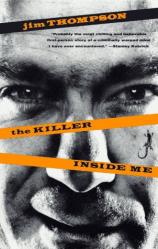Reading Group Guide
Discussion Questions
The Killer Inside Me

1. In a first-person narration, Deputy Sheriff Lou Ford comments to himself, "If there's anything worse than a bore, it's a corny bore" [p. 4]. How does Thompson use dialogue to dramatize Ford's character? When Lou gazes in the mirror, he describes what he sees: the Stetson, a pinkish shirt, a "typical Western-country peace officer, that was me" [p. 28]. In another context, this would be a mundane description, but what more does it tell us about Lou Ford?
2. Lou says he reads German, French, and Italian medical journals. "I couldn't speak any of those languages worth a doggone, but I could understand 'em all" [p. 27], he says. Is his claim credible in the context of what we learn about him? In what incidents is his self-taught education in evidence, and how is it perceived by others? What would erudition represent to a Lou Ford? The journals are in his father's library. What role does his father play in his psyche?
3. Lou's recollections are often ambiguous, more implied than specific, such as his traumatic boyhood involvement with his family's housekeeper, Helene. What is Helene's transgression in Lou's mind, and what role does he ascribe to it in the context of his "sickness"? Is this thought process a recurrent pattern in Lou's pathology?
4. Early in the story Sheriff Bob Maples suggests to Lou, "Watch youself. It's a good act but it's easy to overdo" [p. 25]. Later, at the hotel in Fort Worth, he drunkenly repeats his caution: "Wash--watch y'self.... S-stop all a' stuff spilt milk n' so on. Wha' you do that for, anyway" [p. 85]. Is he implying that Lou's "act" has not been as convincing as Lou thinks? How does Ford react? What is Bob's relationship to Lou, and why does he ultimately resolve it the way he does? Is the relationship credible as portrayed by Jim Thompson?
5. In his treatment of Central City and its citizenry, how does Thompson characterize small-town America?
6. As Lou kills his girlfriend, Amy, he pauses to notice what she's wearing, he sits down to read the paper, he makes puns on her penny-pinching. How do these actions serve the description of a violent act? How important are descriptions of violence in the story of Lou Ford? How, overall, are violent sequences presented?
7. At the novel's end, Lou has set fire to the library and probably the rest of the house. To what extent is this a biblical, spiritual climax? Or is the fire an act grounded in psychological pathology? It is, after all, Lou's father's house. Is the elegiac final paragraph an extension of the spiritual theme, or is it a chilling reminder of the nihilism that has subsumed Lou Ford up until that moment?
The Killer Inside Me
- Publication Date: March 13, 1991
- Paperback: 256 pages
- Publisher: Vintage Crime/Black Lizard
- ISBN-10: 0679733973
- ISBN-13: 9780679733973







